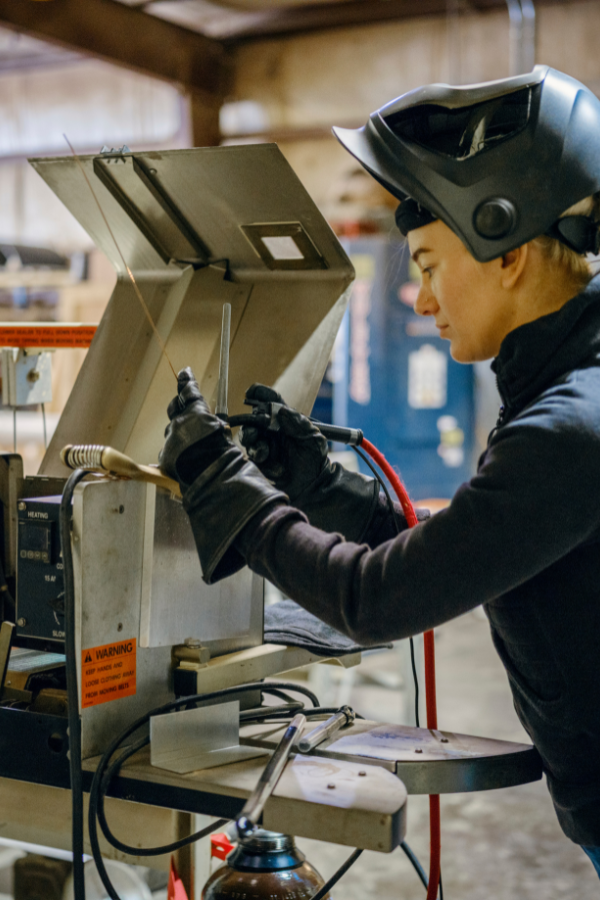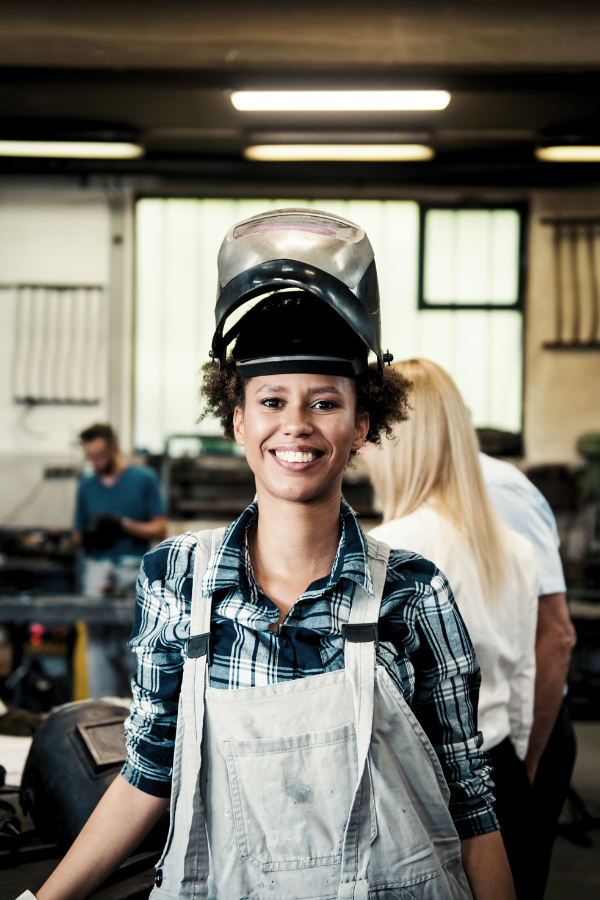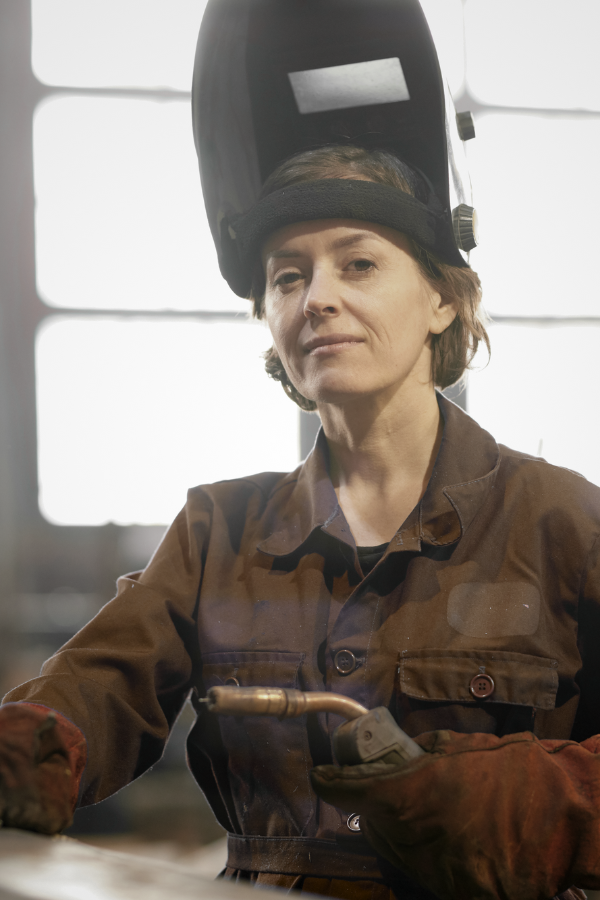
Amazing Women Welders Who Are Transforming the Trades
Summary
Reflection Questions
Journal Prompt
Welding and skilled trades offer incredible opportunities for creativity, job stability, and financial independence, and there has never been a better time for women to explore these dynamic fields. Women like Jessi Combs, who broke speed records and shattered stereotypes, Barbie The Welder (Barbara Parsons), who transforms metal into stunning sculptures, and Stephanie Hoffman, who champions the inclusion of more women in welding through her work with the American Welding Society, demonstrate the profound impact women can have. Michelle de la Vega uses welding to create engaging art installations that inspire and provoke thought, while artists like Gretchen Lothrop and Rona Pondick explore the intersections of natural and human forms through their unique sculptures. Each of these talented women exemplifies how combining skill, passion, and determination can lead to remarkable achievements in welding and trades. Their stories are not just inspiring—they’re a call to action for women everywhere to embrace these professions where they can truly make their mark. Read on to learn more about women welders and their contributions to a traditionally male-dominated industry.
What Exactly Do Welders Do?
Challenges Faced by Women Welders

Women who weld in this country often face several challenges that stem from working in a workforce traditionally dominated by men. Addressing these challenges requires continued advocacy for greater inclusivity, better policies from companies for harassment and discrimination, and more tailored resources, classes, and programs for women in the industry. Additionally, showcasing successful female welders who are making amazing strides in their jobs can help change perceptions and encourage more women to consider welding as a viable and rewarding career path. Let’s take a look at some of the challenges the female welder in your life might struggle against.
Underrepresentation
Women are significantly underrepresented in the welding industry, which can lead to feelings of isolation and a lack of community. This underrepresentation can also affect their access to mentorship opportunities and professional networks.
Stereotyping and Biases
Women welders often confront gender stereotypes and biases about their capabilities in a physically demanding and technically complex field. These biases can impact their career progression and may lead to fewer opportunities for advancement or high-profile projects.
Workplace Culture
The male-dominated culture of many workshops and job sites can sometimes be unwelcoming or even hostile. Women may face harassment or discrimination, which not only affects their job satisfaction but also their mental health and overall well-being.
Work-Life Rhythm
Managing work-life balance can be particularly challenging, especially for women who may have additional responsibilities such as caregiving. The physical demands of welding combined with often inflexible work hours can make this balance more difficult.
Safety and Equipment Issues
The standard safety equipment and uniforms are often designed with men’s bodies in mind, leading to fit and protection issues for women, which can compromise their safety on the job.
Lack of Role Models
With fewer women in the field, aspiring female welders might find it challenging to find role models and mentors who have faced and overcome similar challenges.
Perceptions of Physical Suitability
There are persistent misconceptions about the physical suitability of women for the welding profession, despite the fact that successful welding relies more on skill, technique, and knowledge rather than brute strength.
Six Amazing Female Welders Who Wow Us With Their Work

The percentage of women in the welding profession remains relatively low compared to men. Women typically make up around 5% of the workforce in welding in the United States while guys represent the other 95%. This underrepresentation highlights the gender disparity that still exists in many skilled trades, particularly in fields traditionally dominated by men like welding.
Several factors contribute to this disparity, including historical gender roles, lack of awareness about opportunities for women in trades, and the challenges of workplace culture that may not always be inclusive or welcoming. However, with the increasing focus on diversifying the trades and efforts from various organizations and initiatives aimed at supporting women in these fields, the number of women entering welding and other trades is gradually increasing.
Efforts to encourage more women to consider careers in welding include educational programs, scholarships specifically for women participants, mentorship opportunities, and advocacy to improve workplace culture and policies. These initiatives aim to create a more balanced and inclusive environment in welding and other skilled trades. It’s also important to celebrate women welders who do incredible work. Below are six amazing welders who wow us with their work.
Jessi Combs
Jessi Combs was a highly regarded American metal fabricator, race car driver, and television personality, celebrated for her impressive skills both on and off the track. She appeared on various TV shows including “Mythbusters” and “Overhaulin’,” where she showcased her expertise in metalworking and automotive fabrication. Combs was renowned for her dynamic personality and her advocacy for women in the automotive and fabrication industries, encouraging them to pursue careers in these fields.
Tragically, Jessi Combs passed away in 2019 while attempting to break her own land speed record in a jet-powered vehicle in Oregon. She was posthumously awarded the women’s land speed world record for her run, which reached a speed of 522.783 miles per hour. Her legacy continues to inspire women in the automotive and metal fabrication industries, highlighting her passion for pushing boundaries and breaking stereotypes.
Barbie The Welder (Barbara Parsons)
Barbara Parsons, known professionally as Barbie The Welder, is a self-taught metal sculptor based in Erin, New York. She has gained prominence through her unique metal sculptures and has authored several books aimed at teaching others about metal artistry. Parsons uses her platform to inspire and educate aspiring artists and welders, sharing her knowledge and experiences through social media and her YouTube channel.
Her work often reflects themes of strength and empowerment, resonating with a wide audience and exemplifying the creative potential of welding as an art form. Barbie The Welder’s pieces are characterized by their imaginative designs and the use of reclaimed materials, underscoring her commitment to sustainability in art. She remains a significant figure in promoting welding and metal art, particularly among women.
Stephanie Hoffman
Stephanie Hoffman is a professional welder and the Program Manager for Workforce Development at the American Welding Society (AWS), where she focuses on expanding the welding workforce and promoting welding careers among women and young people. Her role involves a significant amount of educational outreach, working to change perceptions about the industry and encourage more diverse groups to consider welding as a viable and fulfilling career path.
Hoffman’s efforts also extend to supporting current welders through resources, training, and advocacy, aiming to enhance their skills and career opportunities. Her work is pivotal in addressing the skills gap in the welding industry and ensuring the future of a skilled, diverse welding workforce. Stephanie Hoffman’s leadership at AWS highlights her commitment to broadening the reach and appeal of welding.
Michelle de la Vega
Michelle de la Vega is an American visual artist and community activist known for her installations, sculpture, and public art. Her work is deeply personal, often transforming spaces and objects to reflect themes of identity, transformation, and social engagement. De la Vega’s unique approach often incorporates elements of performance and community interaction, making her projects immersive and thought-provoking.
She gained notable attention for converting a garage into a fully functional mini-home, which was documented and widely shared as an example of creative space utilization and minimalist living. This project reflected her interest in affordable housing solutions and her ability to repurpose materials and spaces in innovative ways. Michelle de la Vega continues to inspire with her dedication to art that intersects with social issues and community building.
Gretchen Lothrop
Gretchen Lothrop is an American sculptor who incorporates elements of nature and organic forms into her metalwork, often creating pieces that reflect the intricate details and structures of the natural world. Her work is characterized by fluid lines and forms, achieved through the skilled manipulation of metal. Lothrop’s sculptures often explore themes of growth, decay, and rebirth, inviting viewers to consider the cycles of nature and their own interactions with the environment.
In addition to her artistic creations, Gretchen is committed to environmental conservation, which influences both her art and her choice of materials. Her sculptures not only adorn private collections and public spaces but also serve as a reminder of the delicate balance within ecosystems, showcasing her ability to weld not only metals but also concepts and ideas into her art.
Rona Pondick
Rona Pondick is known for her distinctive sculptures that blend human, animal, and plant forms, creating surreal and often unsettling pieces that challenge traditional notions of identity and corporeality. Her work utilizes a variety of materials, including metals, which she shapes through advanced techniques like casting and welding to form her complex visions. Pondick’s sculptures are celebrated for their technical precision and thought-provoking imagery, often exploring themes of transformation and hybridization.
Her exhibitions have been shown in numerous prestigious venues around the world, earning her a respected place in the contemporary art scene. Rona Pondick’s approach to sculpture challenges viewers to rethink the boundaries between species and the self, making her one of the most intriguing and innovative figures in modern art.
Resources to Help You Start and Support Your Welding Career

There are several organizations and resources specifically aimed at supporting women in welding and helping them start and advance in their careers. These resources often provide training, networking opportunities, scholarships, and advocacy to help address the unique challenges faced by women seeking employment in this field. From offering a welding class once a week to helping you get hired, these organizations will guide you through an industry typically dominated by men (both now and throughout history).
Women Who Weld: Women Who Weld is a nonprofit organization that offers intensive welding training programs specifically for women. This program teaches women who are unemployed and underemployed the skills necessary for careers in welding, helping them gain employment in the industry.
American Welding Society (AWS) Women in Welding: The AWS has a Women in Welding group that focuses on supporting female welders through networking events, educational programs, and scholarships. AWS also provides certifications and a wide range of professional development resources.
Sisters in the Brotherhood: While not exclusively for welders, Sisters in the Brotherhood, part of the United Brotherhood of Carpenters, supports women in various trades, including welding. They offer pre-apprenticeship programs and support throughout a woman’s career in the trades.
Tradeswomen, Inc.: Tradeswomen, Inc. is an organization dedicated to the recruitment and retention of women in skilled trade careers. They offer resources, advocacy, and support for women entering fields like welding.
Canadian Welding Association (CWA) Women of Steel: For those in Canada, the CWA’s Women of Steel initiative provides access to resources, mentoring, and networking opportunities for women in the welding industry.
Institute for Women Of Aviation Worldwide (iWOAW): While primarily focused on aviation, iWOAW encourages women to pursue careers in related technical fields, including welding used in aircraft and aerospace applications. They provide resources and celebrate women’s achievements in these areas.
National Association of Women in Construction (NAWIC): NAWIC offers support for women in all areas of construction, including those involving welding. Their programs include professional development, education, networking, and leadership training.
Step Women’s Network: Step Women’s Network promotes the advancement of women in trades, engineering, and technology. They provide mentorship, networking opportunities, and leadership development to women in these fields, including welding.
The Jessi Combs Foundation: The Jessi Combs Foundation is an excellent resource dedicated to continuing Jessi Combs’ legacy by empowering the next generation of women in industries where they are underrepresented. The foundation focuses on providing educational opportunities, scholarships, and resources specifically geared towards women pursuing careers in trades, skills, and fields that Jessi herself was passionate about, including welding, fabrication, auto-mechanics, and other STEM-related fields.








